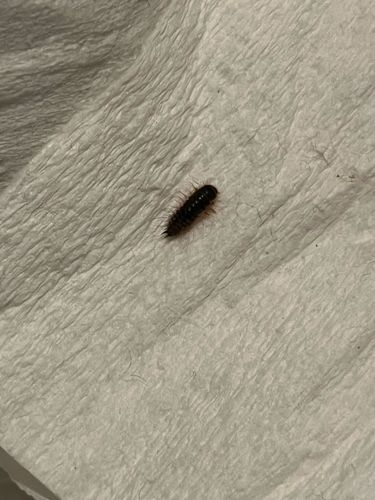Carpet Beetle Larva (likely Black Carpet Beetle or Varied Carpet Beetle)
Scientific Name: Dermestes ater (Black Carpet Beetle) or Anthrenus verbasci (Varied Carpet Beetle) are common possibilities, but definitive identification requires closer examination.
Order & Family: Order: Coleoptera, Family: Dermestidae
Size: Larvae typically range from 2mm to 5mm (0.08 to 0.2 inches) in length, depending on species and developmental stage. They are elongated and typically have dense bristles, often giving them a 'hairy' or 'woolly' appearance.

Natural Habitat
Indoors, carpet beetle larvae are commonly found in homes, museums, warehouses, and other buildings where their preferred food sources are available. They thrive in dark, undisturbed areas such as under carpets, in cracks and crevices, in closets, pantries, and attics. Outdoors, adult carpet beetles are found on flowers and plants.
Diet & Feeding
Carpet beetle larvae are scavengers that feed on a wide variety of organic materials, particularly those of animal origin. This includes wool, silk, fur, feathers, leather, dead insects, pet hair, dried meat, and sometimes even plant-based materials like grains and dried plants. They do not feed on synthetic fibers.
Behavior Patterns
Carpet beetle larvae are typically found in dark, undisturbed areas where their food sources are abundant. They are often found in closets, under furniture, in attic spaces, and in wall voids. They primarily feed at night and are generally reclusive during the day. The larvae moult multiple times, and their cast skins can often be found near infested materials. Adult carpet beetles are often found near windows as they are attracted to light and feed on pollen and nectar outdoors, but they can lay eggs indoors, continuing the cycle.
Risks & Benefits
Potential risks include significant damage to natural fiber products such as carpets, clothing, upholstery, furs, and stored foods. They can also infest insect collections and taxidermy. While generally not harmful to humans, some people may experience mild skin irritation or allergic reactions from contact with their bristles or shed skins. There are generally no direct benefits to humans, but as scavengers, they play a minor role in breaking down organic matter in nature.
Identified on: 9/2/2025